If you’re a CIO or an IT leader, let us ask you a question: can you measure every aspect of your transformation with numbers?
While you can measure digital transformation progress, KPIs don’t account for the human core of transformation: change. And this is what you must manage effectively for your digital transformation to succeed.
While there is a lot of value in key performance indicators (KPIs), it’s also worth considering the benefits of measuring the overall success of your transformation to allow essential adjustments along your digital transformation roadmap. This approach allows you to make necessary adjustments on your route to success.
This article will show you how to measure digital transformation using the following steps:
- Analyze and model new business processes.
- Set business goals, not just IT goals.
- Leverage value stream management.
- Acquire the right tools and frameworks.
- Evaluate progress with feedback from stakeholders.
First, let’s examine why measuring digital transformation efforts is helpful in today’s business market.
- Why Is Measuring Digital Transformation Beyond KPIs Important?
- Whose Responsibility Is It To Measure Digital Transformation?
- How Do CIOs & IT Leaders Measure Digital Transformation?
- What Happens After Measuring Digital Transformation?
- Your Team Is The Key To Digital Transformation Measurement Success
Why Is Measuring Digital Transformation Beyond KPIs Important?
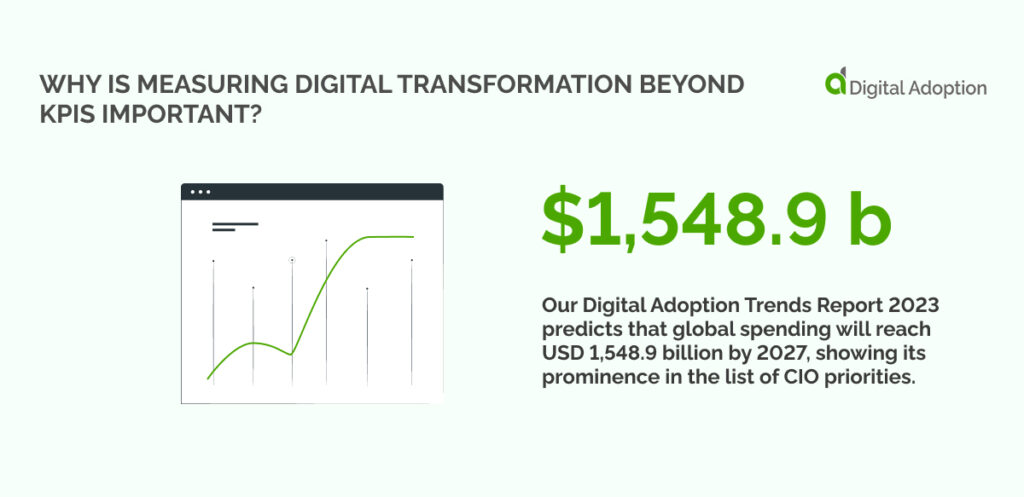
Our Digital Adoption Trends Report 2023 predicts that global spending will reach USD 1,548.9 billion by 2027, showing its prominence in the list of CIO priorities. But despite its importance, embarking on a transformation can be challenging for many organizations, and the desire to measure digital transformation progress is usually the answer to ensure success.
However, it is crucial to be aware that digital transformation initiatives fail too often due to lacking insight into value realization. The conventional way to approach the value measurement of digital transformation is to use KPIs and metrics. However, this is limited in scope as it doesn’t capture all the crucial experiences and viewpoints of the staff driving changes.
Although KPIs and metrics have their place, you also need to capture and respond to the human experience of stakeholders to get the complete picture of progress and drive success. When you do this, you increase your chances of making a return on your digital transformation investments.
By focusing on non-number-based measures of transformation progress and success, you show your staff that you value their experiences and accept their role as the true enablers of digital transformation, higher in value than new digital tools.
Now we have explored the significance of measuring digital transformation beyond KPIs, let’s look at whose responsibility measurement it is.
Whose Responsibility Is It To Measure Digital Transformation?

Because of their role in acquiring and integrating new and innovative technologies into their organization, CIOs and IT leaders are responsible for measuring digital transformation progress. For this reason, when hiring a new CIO or IT leader, ensure they have experience in measuring digital transformation effectively for your company’s success.
Despite the importance of digital transformation measurement in the role of CIOs and transformational IT leaders, it is essential to know how they implement it, which we will cover next.
How Do CIOs & IT Leaders Measure Digital Transformation?
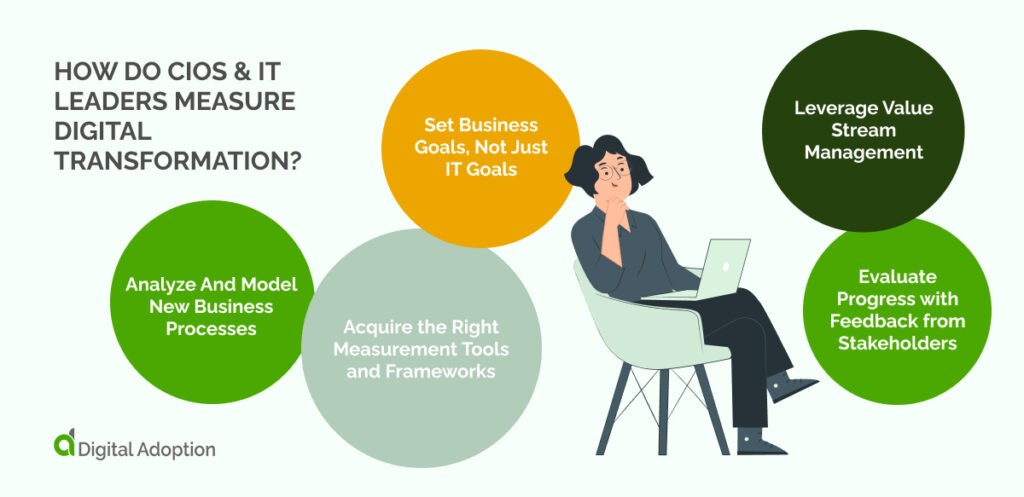
To understand how to assess success and evaluate progress toward objectives in all digital initiatives within your transformation, it’s critical to grasp the changing expectations of CIOs who must report these results and aims.
The pandemic has significantly modified the role of the CIO, making them responsible for more ambitious objectives and a shift away from IT functions. As a result, the CIO’s role today has changed significantly – it is not enough to just manage the IT team.
There are now greater expectations and responsibilities, including being an effective communicator, facilitator, and business planner, leading in transformational development, and managing testing processes, security measures, and compliance regulations. And at the top of the CIO’s priorities is always being aware that digital investments influence revenue.
CIOs and IT leaders use these skills to measure digital transformation by acquiring the right tools and frameworks for measurement.
1. Analyze And Model New Business Processes
It is essential to analyze and model business processes to measure the success of your transformation. The first step is preparation.
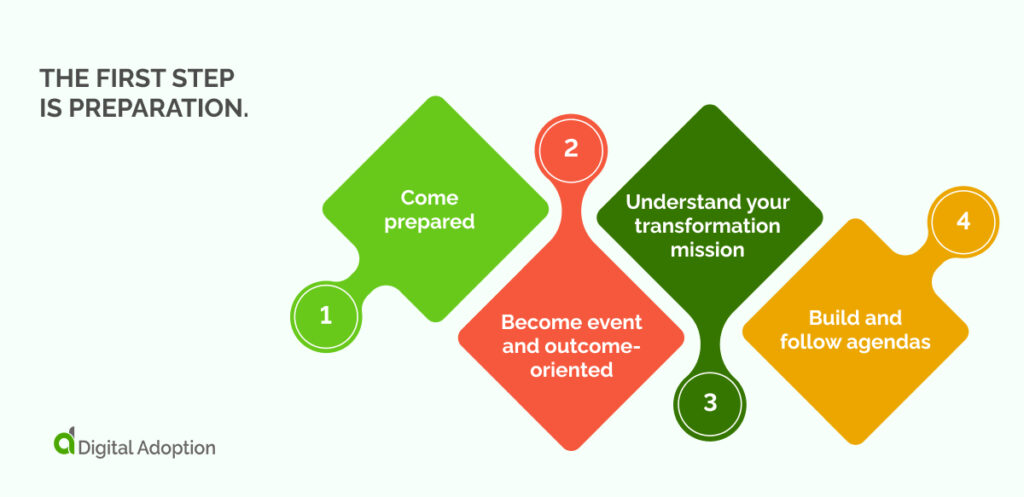
- Come prepared: Master a reliable, proven process for modeling competence and customize it to fit each digital transformation initiative.
- Become event and outcome-oriented: Transform how your business operates by recognizing, normalizing, and defining all processes as outcome-oriented services driven by event completion.
- Understand your transformation mission: Establishing the objective of a business process model is pivotal in each digital transformation project’s journey, enabling successful completion.
- Build and follow agendas: Asking the right questions is much more effective than asking excessive queries.
2. Set Business Goals, Not Just IT Goals
For successful digital transformation as a CIO, it isn’t only necessary that the technology functions appropriately and serves the business objectives. It also means that whatever technological goals are set by CIOs must align with the company’s bottom-line initiatives.
CIOs should establish KPI objectives corresponding to the business’ aspirations and concentrate on appropriate areas. Your organization must decide which KPIs best fit your distinct culture, sector, and mission. You can use customer experience and engagement and reliability or availability figures (such as conversion rates, repeat customers/users, or daily active users) as examples.
A baseline is vital to defining the value of your achievements; not having a baseline makes it hard to see progress. When selecting your KPIs, ensure you can measure them against previous performance. CIOs must guarantee that they benefit everyone and secure buy-in from stakeholders. All organization members must realize success with these goals and measures.
3. Leverage Value Stream Management
Entering unknown waters can be intimidating for CIOs, yet their responsibility to safeguard the organization is paramount. They must ensure the quality of solutions and take accountability for any tools sold or used by customers.
Fortunately, value stream management allows them to track bottlenecks throughout transformation development processes while providing collaboration tools for users to connect effortlessly. Doing so enables CIOs to manage this newfound power and influence effectively.
Value stream management is an invaluable asset to any organization, functioning as a visual roadmap that offers workers and executives real-time feedback on performance. The term “value” refers to the worth of this process in terms of customer satisfaction, while “stream” emphasizes how we measure continuous flow throughout its duration.
Value stream management has proven successful for the transformations of countless businesses across multiple industries when implemented adequately with consistent monitoring over time.
4. Acquire the Right Measurement Tools and Frameworks
Gartner found that 80% of CEOs are increasing digital technology investments to counter current economic pressures. This statistic shows that CIOs are the core of helping prepare the organization for the transformation. Part of their role is to provide reliable tools and frameworks to make the transformation successful.
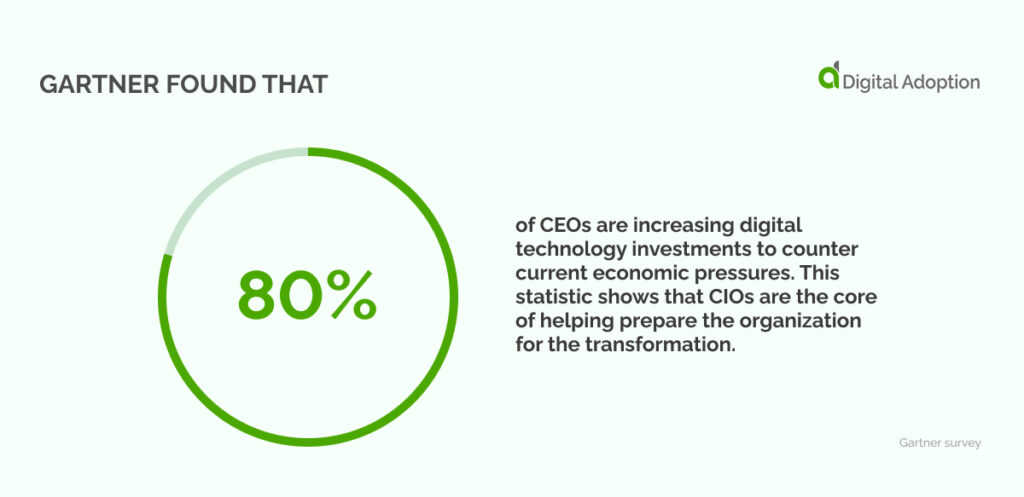
Integrating value stream delivery platforms (CI/CD, testing, artifact management) with agile frameworks like SAFe® (Scaled agile framework®) gives teams an efficient way to deliver applications within the company.
CIOs need an effective platform to monitor progress and plan for the future. Thankfully, technological advancements have allowed us to automate this process instead of manually whiteboarding it – goodbye manual labor! Visually observing, managing, and analyzing your workflows has never been easier. Now CIOs and IT leaders have access to information to make data-driven decisions with successful results for transformation measurement.
5. Evaluate Progress with Feedback from Stakeholders
At every stage of the transformation, it is essential to have buy-in from your employees while using their views to measure progress from the perspective of the frontline users. The most effective way to do this is to ensure they know you value their opinions on the progress of each transformation initiative by collecting their feedback in various ways. Doing so can also improve employee retention as part of effective change leadership.
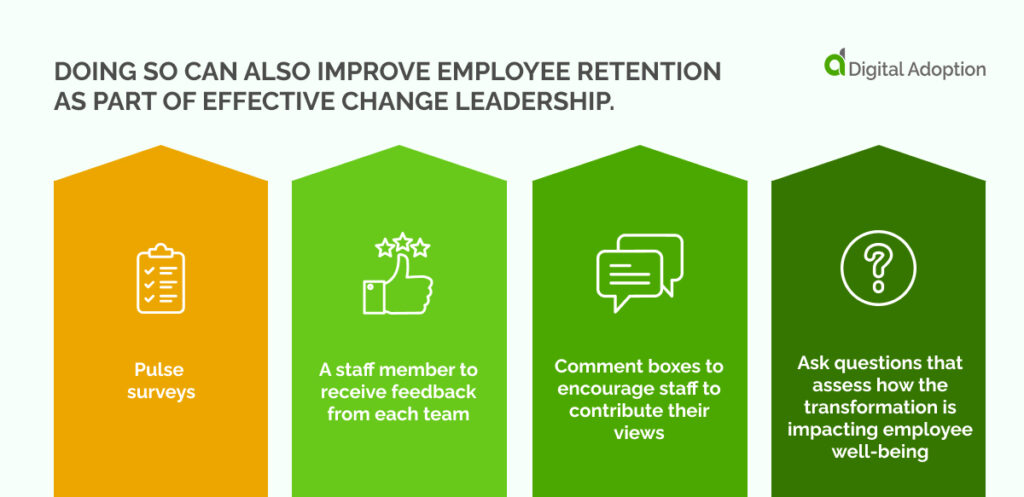
- Pulse surveys.
- A staff member to receive feedback from each team.
- Comment boxes to encourage staff to contribute their views.
- Ask questions that assess how the transformation is impacting employee well-being.
Following these steps to analyze and model your business processes will help guide your transformation measurement process by providing a structured method that works for your company.
What Happens After Measuring Digital Transformation?
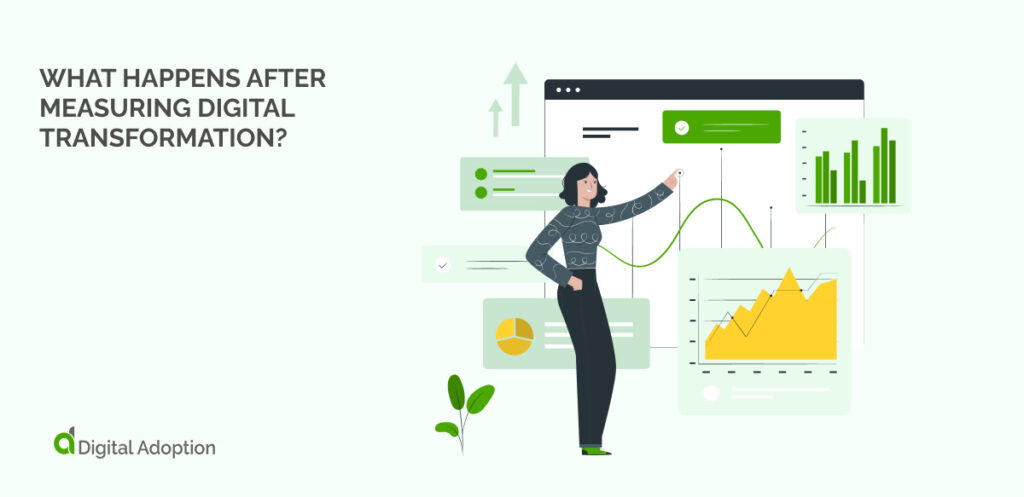
The period after measuring a digital transformation is as important as during the transformation because if you don’t complete the right actions, the word of the transformation will be lost, as new behaviors won’t stick. In addition, you will waste investment into transformation if you don’t maintain it long-term.
The most successful digital projects involve collecting feedback from all relevant parties at every stage of the digital transformation journey. When the digital transformation measuring process is complete, review, assess and adjust the digital transformation based on feedback. If you haven’t already done so, broaden the feedback collection to shareholders to ensure the transformation meets all parties’ needs.
When you have collected this feedback, it is time to act on it. Doing so improves the effectiveness of your digital transformation and shows staff and shareholders that you value their views as you always act on their feedback where possible.
Your Team Is The Key To Digital Transformation Measurement Success

Numbers have their place, but your team is the most critical asset in a successful digital transformation measurement. While KPIs, metrics, and technical data can give you an idea of how your digital transformation is going, there’s no substitute for actual human input.
If you want to ensure that your digital transformation investment is on track, pay careful attention to what your team has to say – listen to their insights, needs, and experiences to ensure they get the resources they need. Your team is essential in creating effective strategies for measuring digital transformation progress, as high employee engagement can lead to transformation ROI.
So start listening to your team today – your employees can make all the difference when measuring digital transformation success!

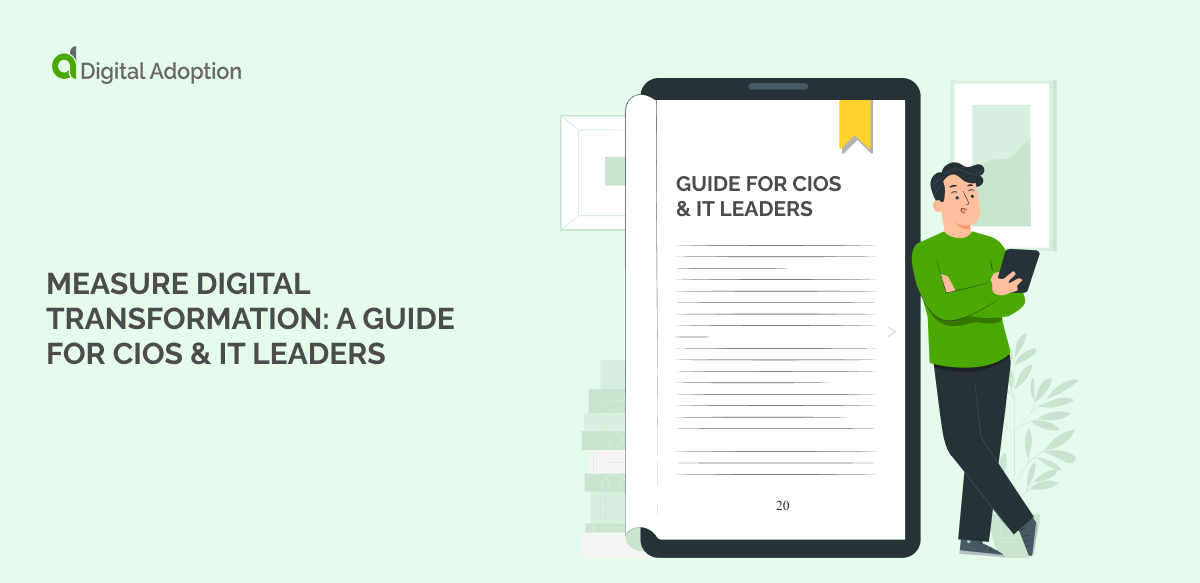


![4 Best AI Chatbots for eCommerce [2025]](https://www.digital-adoption.com/wp-content/uploads/2025/03/4-Best-AI-Chatbots-for-eCommerce-2025-img-300x146.jpg)


![13 Digital Transformation Enablers [2025]](https://www.digital-adoption.com/wp-content/uploads/2025/02/13-Digital-Transformation-Enablers-2025-img-300x146.jpg)



![4 Best AI Chatbots for eCommerce [2025]](https://www.digital-adoption.com/wp-content/uploads/2025/03/4-Best-AI-Chatbots-for-eCommerce-2025-img.jpg)

